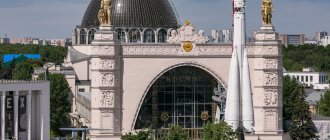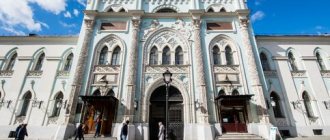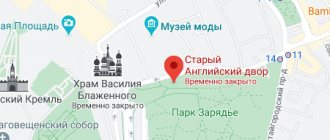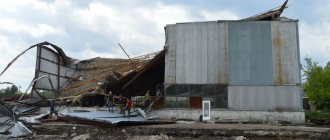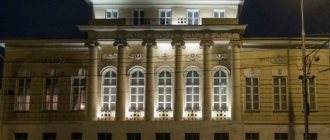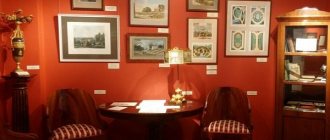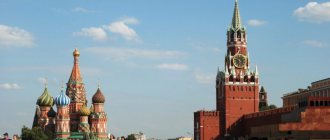The Armory Chamber can be called a real treasury of the Kremlin Palace. It is located in a building erected in 1851. The collection is based on valuable items that were kept for centuries in the royal treasury.
Many items were received as gifts from representatives of other states, others were made in the palace workshops. The chamber displays the regalia of government officials, vestments of hierarchs, silver items and jewelry and many other items. In total, these are as many as 4 thousand exhibits, executed at the highest artistic level.
Story
By order of Peter the Great, the sovereign's workshops and warehouses were to be transformed into a museum. This institution was to be named after the oldest storage facility - the Armory Chamber. But only Alexander I managed to complete this work in 1806.
A separate building was built for the new exhibition. During the work, a study and inventory of the collection was carried out. Everything was led by Honorary Member Malinovsky. The first part of the catalog was published a year later. The circulation was paid for personally by Emperor Alexander I. Malinovsky was the first to describe the section of the exhibition - State regalia.
The building to house the collection was built by the architect Egotov. It was ready in 1809, but finishing continued until the summer of 1812.
- Diamond Fund of the Moscow Kremlin
- Sights of the Moscow Kremlin and Red Square
During Bonaparte's entry into Moscow, the building was damaged. The valuables were evacuated, but due to the fact that they were stored in boxes, the exhibits lost their former splendor. Restoration was required. After reconstruction of the building and work with artifacts, the exhibition moved to its permanent location. This happened only in 1814.
The purpose of organizing the exhibition is to cultivate patriotic feelings among Russian citizens and remind them of military exploits.
It soon became clear that the building did not meet many of the requirements. There was no heating, the exhibits were damp and affected by fungus. Wooden structures could easily catch fire. It was decided to place the Kremlin garrison in the Egotov building, and to build a new room for the exhibition.
Photo: pastvu.com
The Yegotov building was used as barracks for more than 100 years. Then the Soviet government decided to build the Kremlin Palace of Congresses, and the first building of the Armory Chamber was demolished.
Guests of Moscow are recommended…
The Kremlin museum complex, and especially the Armory Chamber, is recommended for visiting by all guests of the capital. Both foreign and domestic tourists will discover a lot of new things after getting acquainted with this unique collection. After all, the exhibits presented here speak for themselves; they reveal to visitors the true history of not only our country, but also the entire Eurasian continent. After all, written sources were often written to please the current government, distorting real events. And the collected artifacts can tell about the true events of that time, you just need to be attentive and ready to accept something new. A repository of priceless exhibits, a treasury of cultural and historical heritage not only of the Russian people, but of the whole world - these are the characteristics that the Armory Chamber of the Moscow Kremlin deserves. Tickets for visiting this, let's not be afraid of this comparison, wonders of the world are sold at the museum box office 45 minutes before the start of the show. Every day, except Thursday, there are 4 sessions: at 10.00, 12.00, 14.30 and 16.30
Architecture
Egotov built the first building in the classicism style. The cornice was decorated with heroes who glorified the country at different times, and diplomats.
Here were the images:
- Minin and Pozharsky
- Peresvet and Oslyabi
- Ermak Timofeevich
- Matveeva
- Golitsyna
- Ordina-Nashchokina
The facade was decorated with scenes of heroic events in Russia. One could see pictures of Vladimir’s choice of Orthodoxy, Russia’s access to the seas in the south and north, and deliverance from the Tatar-Mongol yoke.
The building had 2 floors. The first housed the archive, a model of the Grand Kremlin Palace designed by Bazhenov, and crews. The second is the exhibition itself. In the Crown Hall one could see the sovereign's regalia, among them the Monomakh cap.
A new building was built at Kolymazhny Yard according to Ton’s design. It blends organically with the Grand Kremlin Palace: the same columns, two-light windows. The building is located on a plinth of different heights. The combination of styles is quite bizarre: features of Russian architecture of the 17th century and Gothic can be traced.
The enfilade has an axis from which 2 round halls are separated. The halls are separated by bars on which double-headed eagles are depicted. In the imperial treasury, marble medallions are inserted into the walls. They depict the rulers of the state.
Patriarchal Chambers
The housewarming was celebrated in mid-1655, and the entire Romanov family came to it. Patriarch Nikon wanted his premises to be designed in the most saturated colors. The chambers are built in a more classical, “simple” style, but this is significantly compensated by the richness of the building’s decor and the riot of colors of the Temple of the Twelve Apostles adjacent to the east. The third floor with small rooms was completed only at the end of the 17th century. Several white stone porches, allowing access to open galleries, gilded openwork ridges, and magnificent frescoes gave the Patriarchal Chambers a solemn appearance. The pink color Nikon ordered to paint the walls of his apartment especially set off the gilded splendor. The modern appearance of the chambers leaves a feeling of some kind of understatement; perhaps the project was not fully realized.
Exposition
The main part of the exhibition is the rarities of the emperors. They were made in palace workshops and received as a gift from state ambassadors. Exhibited here:
- ceremonial and coronation clothes of emperors
- state regalia
- collection of gold and silver items by Russian masters
- vestments of the patriarchs
- weapon
- ceremonial harness
- royal carriages
- Western jewelry
An entire section of the center is dedicated to arts and crafts. Objects from Russia, Western and Eastern countries are presented.
- 35 best museums in Moscow
- Sights of Moscow
- What to see in Moscow in 3 days – 25 most interesting places
Zaryadye in Moscow
One of the most ancient districts of Moscow, which runs between Varvarskaya Street and the river, is a historical monument just by its location. This area contains unique buildings of Russian architecture - churches, temples and cathedrals built in the 14th-18th centuries. But Zaryadye in Moscow gained the greatest tourist popularity as the birthplace of the Romanov family, the Russian tsars. The name of the territory comes from the word “row”, meaning the shopping arcades that stretched to Red Square. Unfortunately, the monument has not survived to this day in its original form; only the chambers remain. The remaining elements of the house and yard can be judged from the surviving descriptions of the life of the boyar family. According to legend, the first Russian Tsar from the House of Romanov was born in the house on Varvarka, which his grandfather once built. During the reign of Ivan the Terrible, the chambers were destroyed by archers on the orders of the tsar, and subsequently suffered many times from fires and all kinds of redevelopment into monasteries and churches. The museum was organized on this site only on the instructions of Alexander II, in the middle of the 19th century. The history of the Romanovs began here. In terms of the structure of the premises, the chambers had a fairly standard appearance of houses of that time. The underground part was occupied by basements and storerooms, and there was also a cookhouse or kitchen. The living quarters were located higher: a library, an office, and a study room for older children were intended for men. The women's half of the house was more spacious, with bright rooms for needlework, and the boyars' daughters were engaged in spinning and sewing together with the maids. The decorations, dishes, furniture, sewing, and household items that have survived to this day amaze with their simplicity and sophistication of decoration. The Romanov chambers in Zaryadye are called the “old sovereign’s courtyard.”
Halls
Artifacts are distributed across several rooms:
- Hall 1 displays the most ancient treasures. Jewelry once belonged to the princes, and then to the kings of the state. The stands display items brought from Byzantium in the 4th-15th centuries. The exhibits of pre-Mongol Rus' leave no one indifferent. Items of decorative and applied art were made in Suzdal, Kyiv, Chernigov, and Ryazan. The display cases contain gold and silver jewelry produced in Muscovy in the 15th and 16th centuries. A separate stand is dedicated to silverware from Veliky Novgorod craftsmen.
- Hall 2 displays jewelry made by craftsmen from the 17th to the 20th centuries. The core of the exhibition is the treasures of the Kremlin’s Golden and Silver Chambers. In addition, products from provincial craftsmen from Solvychegodsk, Veliky Ustyug, Kostroma, and Veliky Novgorod are on display. The following stands display the products of master jewelers from famous houses: Faberge, Ovchinnikov, Semenov, Khlebnikov.
- Hall 3 displays weapons that were produced in different countries of the West and East. Armament was either specially purchased or donated by ambassadors.
- Hall 4 displays weapons made by Russian craftsmen from the 12th to the 19th centuries. There is an extensive collection of bladed weapons and firearms. Ceremonial and hunting weapons are displayed separately. It is distinguished by rich decoration.
- Hall 5 is dedicated to silverware from Western craftsmen. Basically, the artifacts are gifts from ambassadors of friendly countries.
- In Hall 6, ceremonial and coronation costumes of the imperial family are displayed. In addition, the vestments of the metropolitans and patriarchs of the Russian Orthodox Church are exhibited here.
- Hall 7 is dedicated to objects that were used in ceremonies. Some of them were inherited and over time began to have political significance.
- In Hall 8 you can see elements of the ceremonial harness.
- Hall 9 will delight visitors with ceremonial royal carriages.
- 25 best excursions in Moscow
- 22 best Moscow parks for walks
- 20 most beautiful places in Moscow
- 30 best things to do in Moscow for kids
What to see
The elegant building of the Armory Chamber from the outside resembles a real palace. Graceful arched windows decorated with stucco, slender pilasters - all this fits perfectly into the architectural ensemble of the Moscow Kremlin. But still, the main splendor is located inside - in the 9 halls of this huge museum, which occupies two floors.
data-captiontag=”dd” data-columns=”0″ data-size=”large” data-width=”1000″ data-auto=”false” data-max-width=”100%” data-ratio=” 1.8″>
The building looks like a real palace
Scheme of the Moscow Kremlin
The first floor is dedicated to household items, lush dresses and ceremonial kaftans of noble persons, as well as luxurious carriages. The carriage exhibition is one of the most interesting places in this museum; it always attracts visitors. Here you can see 24 carriages, the oldest of which dates back to the 16th century. Also among the interesting exhibits it is worth highlighting the carriage of Catherine II.
data-captiontag=”dd” data-columns=”0″ data-size=”large” data-width=”1000″ data-auto=”false” data-max-width=”100%” data-ratio=” 1.8″>
On the ground floor you can see elements of the wardrobe of the Russian nobility
Various household items of aristocrats
The museum houses 24 carriages, the oldest of which is from the 16th century
At the stairs, before going up to the second floor, you can admire the figures of men-at-arms clad in 17th-century armor. This light marble staircase is a work of art in itself. As for the second floor of the museum, it differs not only in the theme of the exhibition, but even in the interior - everything here looks lighter, lighter and more airy.
data-captiontag=”dd” data-columns=”0″ data-size=”large” data-width=”1000″ data-auto=”false” data-max-width=”100%” data-ratio=” 1.8″>
Figures of men-at-arms near the stairs on the first floor
The staircase itself also looks like a piece of art
At the top are jewelry, royal regalia, dishes and coins, and numerous gifts to the Russian tsars. Of particular interest is the Crown Hall, where ancient symbols of state power are displayed: scepters, orbs, precious chains and royal caps, which have long replaced crowns in Rus'. Among them there is the famous Monomakh hat, as well as several other headdresses created in honor of the annexation of Kazan, Siberia, etc.
Halls
of the Armory Chamber :
- No. 1 - jewelry made of gold and silver, royal jewelry;
The first hall displays jewelry
- No. 2 - valuable dishes, samovars, dishes, ceremonial bowls and goblets;
You can look at various dishes in hall No. 2
- No. 3 - armor and weapons from around the world, collected over the period from the 13th to the 19th centuries;
Armor from different countries of the world in hall No. 3
- No. 4 - Russian chain mail, helmets, sabers, firearms from the time of Ivan the Terrible;
The fourth hall displays weapons from the time of Ivan the Terrible
- No. 5 - gifts to Russian tsars from European rulers (mainly jewelry and household items);
- No. 6 - luxurious fabrics of Eastern and Western masters, costumes for coronations;
Room 5 presents fabrics and costumes
- No. 7 is a small but very valuable collection of royal regalia that was used at ceremonial receptions.
Regalia of various times can be found in room 7
- No. 8 - horse harness and accessories for riding, as well as a collection of valuable fabrics;
- No. 9 is a collection of antique carriages, among which is Boris Godunov’s carriage from the 16th century.
Boris Godunov's crew in hall 9
The most valuable exhibits
The most important relic of the Armory is considered to be the Monomakh cap - one of the oldest and most famous symbols of royal power in Rus'. There is still debate about its origin, but according to the main version, it was created from the helmets of Dmitry Donskoy (the winner of the Battle of Kulikovo) and his brother, Prince Ivan of Zvenigorod. It is believed that this headdress appeared around 1505-1526, although some of its elements date back to the 13th century. The hat got its name in honor of the Byzantine ruler Constantine Monomakh, who allegedly gave it to Prince Vasily III (but this is rather a legend).
The hat of Vladimir Monomakh is considered the most important exhibit of the Armory Chamber
There are other interesting items in the Armory. For example, this is a double royal throne of the 17th century, which was created for the princes John V and Peter I. Also in the collection is a helmet that belonged to the son of Ivan the Terrible, several Faberge Easter eggs, a Dutch suit of Peter I, sabers of Minin and Pozharsky, and Boris's chain mail Godunov, keys to the city of Riga, etc.
data-captiontag=”dd” data-columns=”0″ data-size=”large” data-width=”1000″ data-auto=”false” data-max-width=”100%” data-ratio=” 1.8″>
One of the Faberge eggs in the museum
Double throne of co-rulers Peter and Ivan
Helmet of Dmitry Donskoy - Moscow prince and commander
Most of the unique things are in the halls with weapons and royal regalia, but there are also pearls among valuable dishes. For example, in room No. 3, a special place is occupied by a precious bowl, which was once laid in the foundation during the construction of the Transfiguration Cathedral personally by Prince Yuri Dolgoruky (the legendary founder of Moscow).
The bowl, once laid in the foundation of the Transfiguration Cathedral, by Yuri Dolgoruky
Interesting: the design of the double throne for the young princes John V and Peter I provides a compartment with a small door. It was probably created so that an experienced courtier could suggest the necessary words and actions to young rulers during ceremonial receptions.
Opening hours and ticket prices
The Armory is open for tours:
- Every day except Thursday - from 10:00 to 18:00.
Tours run 4 times a day, with the last one starting at 4:30 p.m.
Cash desks are open:
- Every day except Thursday - from 09:00 to 16:30.
In winter, ticket offices open half an hour later.
Information can be found on the chamber's website.
Ticket prices:
- For adults - 1000 rubles;
- For students and pensioners - 500 rubles.
Children under 16 years old can enter for free.
In addition to tickets at the Alexander Garden box office, you can also purchase electronic tickets on the museum’s website.
For self-guided excursions, there are audio guides and a mobile application with a guide; you can download it on the Armory Chamber website.
The Armory Chamber is a popular place among tourists
Interesting Facts
- In 1930, a Gokhran commission removed more than 300 valuable exhibits from the collection, which were subsequently sold to private individuals in foreign countries. In particular, among the seized items were 11 Faberge eggs. There is an opinion that this incident was the reason for the suicide of the museum director D. Ivanov, who tried to prevent the sale of relics.
- In total, the Armory houses more than 4,000 exhibits, of which the earliest date back to the 13th century. Since many of them were donated by foreign ambassadors, the exhibition includes items from all over the world.
- In 1737, the treasury museum suffered a fire, as a result of which some of the exhibits were lost. It was this event that became the impetus for the construction of a separate building for the surviving treasures (today this building no longer exists).
Courtyard attraction
Useful tips
- Visiting rules prohibit photography and video shooting inside the museum building. But professional photographers may request permission to take photographs.
- It is prohibited to enter the museum halls with animals and large items, as well as scooters, roller skates, etc. The only exceptions are children's strollers and wheelchairs.
- Visitors can deposit large bags or other items that are prohibited or inconvenient for the excursion in a storage room; it can be easily found in the Alexander Garden.
Virtual tour of the Armory Chamber
Main exhibits
By analogy with the 7 wonders of the world, 7 unique exhibits can be distinguished in the Armory:
- Of course, Monomakh's hat. Precious sable fur surrounds a patterned golden crown. This in itself is beautiful. But the hat also has enormous historical value.
- Feather-egrette with sapphire. The horseman's decoration was presented to Catherine the Great by Sultan Abdul Hamid after the conclusion of the Kuchuk-Kainardzhi Peace. The aigrette feather is decorated with a rare yellow sapphire.
- Sleigh carriage. Nowadays such a combination will surprise few people. And in the time of Elizabeth Petrovna this was an innovative solution. Historians claim that the empress traveled in a strange carriage from St. Petersburg to Moscow for only 3 days. Typically, such a journey took about 10 days. A few carts have survived, the Elizabethan one being one of them.
- Ermine robe of the last Empress Alexandra Feodorovna. The skins of 800 animals were used for ceremonial clothing. And preserving the relic was not easy.
- Greater Zion. This tabernacle was previously used in the Assumption Cathedral of the Kremlin. Its uniqueness lies in the fact that it is designed in the form of an Orthodox church. Date of manufacture: 15th century. But some researchers are of the opinion that some rarity elements are much older.
- Osten-Sacken weapon set. The set was presented by the Parisians to Governor Osten-Sacken as a token of gratitude for the exemplary behavior of the Russian troops in the captured city. On the handle was a 35-carat diamond, stolen in the 20s of the twentieth century. During the restoration, the stone was replaced with a similar one.
- Linen cup. According to tradition, vassals presented such a cup filled with coins to their master. The peculiarity of the rarity is that the insects and frogs cast from silver were alive at the time of manufacture. In Germany in the 15th century, this technique was common.
Golden-Domed Teremok
The highest part of the Terem Palace, from which an amazing view of Moscow opens, was built for the children of Mikhail Fedorovich - they were supposed to study there. The Teremok is located above the Tsar's Throne Chamber. The room is spacious, bright, with benches arranged along the walls. It also served for meetings of the Boyar Duma, and was sometimes used as the royal office. The perimeter of the tower is surrounded by open galleries for walking: at the end of the building these are large, full-fledged areas, and the long side consists of narrow passages, which are equipped only with low parapets. From here the entire building, as well as the entire ancient city, was clearly visible. The Golden-Domed Tower was built in 1637; it is a unique creation of Russian architects. The room is very richly decorated, but at the same time cozy and warm, large windows let in a lot of light, colored mica stones created a whimsical play of different colors. The roof cornice is decorated with an openwork metal lattice; the window casings are covered with elaborate white stone carvings (as in the “adult” part of the chambers), which are different on each window. Birds, flowers, animals, various fruits and fairy-tale characters decorate the reliefs, symbolizing the diversity and richness of the surrounding world. The western portal, open for viewing, is decorated with a board that contains an inscription about the ownership of these choirs by the sovereign's children - Tsarevich Alexei Mikhailovich and Ivan Mikhailovich. Between the text and along the edges of the relief there is a design that helps to awaken interest in learning and playing in the specified room. The image, from the point of view of a modern person, looks naive and unassuming, but the skill of its creators is difficult to overestimate. You can describe the Golden-Domed Tower endlessly, and the main theses will be: bright, warm, lively, magnificent.
Excursions
The Armory is a limited space. Therefore, the number of visitors is also limited. Excursions are organized for guests. You can rent an audio guide in Russian or a foreign language, or use a mobile application.
The exhibition administration warns that when entering through the Borovitsky Gate there may be a queue of 30-40 minutes.
- Moscow hotels with swimming pool
- Moscow hotels with panoramic views
- Moscow hotels near Red Square
- Moscow hotels for lovers
How much does it cost to visit the museum?
The cost of a full ticket is 700 rubles. However, for pensioners, students and schoolchildren the price will be only 200 rubles. In addition, on weekends and holidays you can purchase a family ticket to visit the Armory. The cost of the excursion will be 200 rubles for each family member. And every third Monday of the month, persons under 18 years of age can visit the museum completely free of charge. In addition, every day for disabled people of groups 1 and 2, large families, conscripts, military school cadets of the 1st and 2nd courses, WWII veterans, preschoolers, orphans, and museum workers, visiting the Armory Chamber is free.
Interesting Facts
Under Ivan 3, the Great Treasury was located on the territory. Historians consider it the predecessor of the future Armory Chamber. In the first half of the 16th century, the Armory Order was formed. It was used to store weapons. In the second half of the 16th century the name changed to the Armory.
Few people know that Ivan 4 organized workshops in the weapons storage facility. Various items were manufactured there according to the sovereign's order. In the second half of the 17th century, the storehouse was supplemented with art objects. It was from this time that the pantry became the center of all-Russian national art.
The sovereign's workshops produced:
- weapon
- banners
- armor
- gilded bone and wood
- cut and forged iron
- painted icons
The chamber's funds were damaged during the Kremlin fire in the first half of the 18th century. The banners of the regiments of Charles of Sweden, captured in the Battle of Poltava, burned down. Some of the rarities were damaged and could not be restored. The treasures that survived the fire were placed temporarily in the Terem Palace.
The building built for the treasury had no heating. In addition, it was made of wood, that is, a fire hazardous material. The rarities either dried out or became damp, molded and rusted. It turned out to be too expensive to refurbish the old premises. Therefore, it was necessary to build a new building.
By the beginning of the War of 1812, the exposition funds were quite impressive. They were evacuated to Nizhny Novgorod. Unfortunately, the conditions at the temporary storage site turned out to be unsuitable: some of the items required restoration.
During the Great Patriotic War, the issue of preserving rarities arose. At first it was planned to hide the exhibits in the Taynitskaya Tower. But by the fall it became clear that evacuation was inevitable. The treasures were loaded into wagons and sent to Sverdlovsk. 11 employees went with valuables. The operation was secret, controlled by the NKVD.
In Sverdlovsk, the local NKVD accepted the rarities for storage. The employees were housed in barracks. But the values did not go unchecked. Evacuated workers examined the treasures and carried out restoration on their own.
Exhibits that were difficult to transport were left in the Kremlin Armory: carriages, thrones. They were preserved by the employees who remained in Moscow. The work was supervised by the Kremlin commandant and the museum director. In 1943 they were awarded orders.
Preparations for the return of the rarities began after the threat looming over Moscow had passed. It took several years. The treasures returned to their permanent place only in February 1945.
Turret
Probably, when constructing the tower, the architects meant the physical elevation of the sovereign over his lands. The tsar looked at the city from its highest point (if you do not take into account the bell tower of Ivan the Great), that is, he was between God and people, which allowed him to assess the situation and make large-scale decisions. For the inquisitive Tsarevich Alexei Mikhailovich Romanov, this height seemed completely mastered. Therefore, a “watchtower” was attached to the tower on the eastern part. The floor level of this small structure coincided with the roof of the highest point of the Terem Palace. Construction took place later, which is why the eastern portal of the tower was not accessible to view, although initially it was decorated as beautifully as the western one. The turret offered the best view, but the princes probably liked to be above their father and all the noble boyars who occupied their room for a short time. There were two ways to get there: through the Golden-Domed Tower, which was connected by a white stone staircase to the vestibule of the turret, forming a passage from the eastern portal, or directly from the lower chambers. In this case, the visitor found himself in a small vestibule next to the tower and from there, through the open space, reached the vestibule, from which he could ascend to the room we were considering.
Visiting rules
Citizens wishing to visit the exhibition must follow the rules:
- arrive at the time indicated on the entrance ticket
- leave large items in the storage room
- Visiting the exhibition with animals is prohibited
- It is forbidden to linger at the exposure after the end of the session
- It is prohibited to be in the exhibition area while intoxicated
- It is prohibited to talk loudly or make noise during the tour
- It is forbidden to conduct your own excursion
- Video or photography is prohibited
- It is prohibited to bring food and drinks, including alcoholic ones.
- food and drinks are prohibited
- It is prohibited to run around the exhibition area
- It is prohibited to go beyond the established fences
If the rules are violated, the administration has the right to remove the visitor from the exhibition area. In case of active disobedience, measures may be taken in accordance with the laws of the Russian Federation.
Amusing Palace
The Romanov chambers, for all their splendor and spaciousness, could not accommodate the whole family. Therefore, in 1651, by order of the new Russian Tsar Alexei Mikhailovich, the construction of a new building began on the territory of the Moscow Kremlin, which was intended for the residence of his wife’s father (father-in-law) I. D. Miloslavsky. It is worth noting an amazing feature of the structure - it became the first Moscow “skyscraper”, as it consisted of four floors. Already in the middle of the 17th century, there was a shortage of building space. Inside the first floor there was a through passage 30 meters long. Above the living rooms, for the convenience of the owner, the Church of the Praise of the Virgin Mary with belfries was built, the altar of which was carried outside the palace with the help of brackets. It hung over the Kremlin street, thus all church canons were observed. Miloslavsky lived in this house for 16 years, after which the palace passed into the state treasury. It received the name “Amusing” later, in 1672, under Fyodor Alexandrovich Romanov, when the sovereign’s sisters moved into it. The premises were used for the amusement of the royal court (fun): the first theatrical performances were staged here, hence its name. For the convenience of the royal family, the Teremnaya and Poteshny Palaces were connected by closed passages.
Armory Chamber of the Moscow Kremlin on the map
Armory Chamber Museum in Moscow
- Where to relax by the sea in autumn - 20 best destinations
- Hotels in the center of Rome
- What to see in Alicante in 1 day - 15 most interesting places
- Geirangerfjord in Norway
- Sights of Kos Island
- Carlsbad Caverns in the USA
- In the near future, tourists will be able to visit the royal residence in Bulgaria
- Moscow 5 star hotels in the center
- Bulgarian hotels with water park and slides
- Holidays in Dubai all inclusive
- Tours to Vietnam for 9, 11, 12 and 13 nights, 3 and 4* hotels with breakfast from RUB 95,477 for two – March, April
- Charles Bridge in Prague
+1
Tsarskoye Selo
Starting from Peter I, all Russian emperors left their mark on the history of the formation of the modern appearance of the city of Pushkin, or rather, its unique architectural and park objects. Before the Bolsheviks came to power, this place was known as Tsarskoe Selo. The Alexander Palace, as well as the Catherine Palace, together with the adjacent territories and complexes of buildings, are real works of art! On the territory of the modern museum, all directions of artistic styles are found - from the luxury of Russian Baroque to classicism and more modern trends of the 20th century. The Catherine Palace in Tsarskoe Selo allows you to feel the spirit of several eras of the reign of the Romanov dynasty. Catherine the Great, Elizabeth, Alexander I - all left their mark on the development of the external appearance and internal contents of the palace. Of no less importance for the integrity of perception is the park area adjacent to the ensemble, which was created individually for each structure. The era of the reign of Alexander I, Nicholas II (the last Russian emperor) is associated with the Alexander (New Tsarskoye Selo) Palace. From a historical and architectural point of view, these objects are no less important than the Kremlin Palace. Photographs, video materials, and constant excursions to all places where the Romanov house was located are in constant demand both within our country and among many foreigners.
